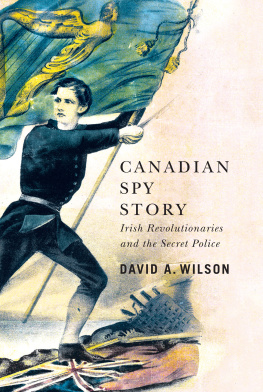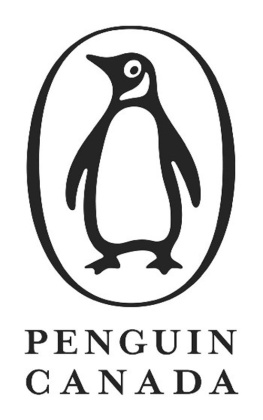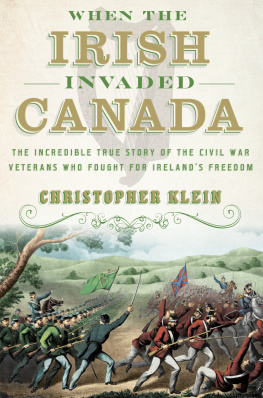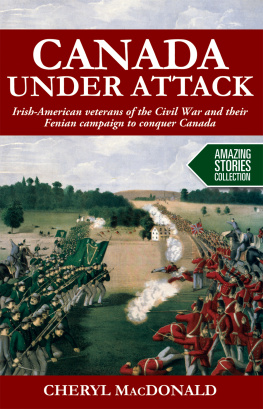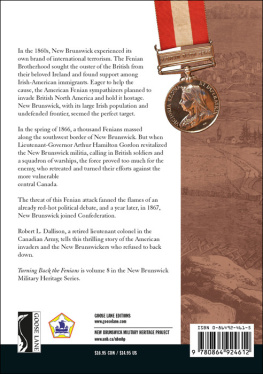Contents
Page List
Guide

CANADIAN SPY STORY
CANADIAN SPY STORY
Irish Revolutionaries and the Secret Police
DAVID A. WILSON
MCGILL-QUEENS UNIVERSITY PRESS
MONTREAL & KINGSTON LONDON CHICAGO
David A. Wilson 2022
ISBN 978-0-2280-1117-0 (cloth)
ISBN 978-0-2280-1360-0 (ePDF)
ISBN 978-0-2280-1361-7 (ePUB)
Legal deposit second quarter 2022
Bibliothque nationale du Qubec
Printed in Canada on acid-free paper that is 100% ancient forest free (100% post-consumer recycled), processed chlorine free
This book has been published with the help of a grant from the Federation for the Humanities and Social Sciences, through the Awards to Scholarly Publications Program, using funds provided by the Social Sciences and Humanities Research Council of Canada.
We acknowledge the support of the Canada Council for the Arts.
Nous remercions le Conseil des arts du Canada de son soutien.
Library and Archives Canada Cataloguing in Publication
Title: Canadian spy story : Irish revolutionaries and the secret police /David A. Wilson.
Names: Wilson, David A., 1950- author.
Description: Includes bibliographical references and index.
Identifiers: Canadiana (print) 20220131058 | Canadiana (ebook) 20220131147 ISBN 9780228011170 (cloth) | ISBN 9780228013600 (ePDF) | ISBN 9780228013617 (ePUB)
Subjects: LCSH: Fenians. | LCSH: Fenian Brotherhood. | LCSH: Spies CanadaHistory19th century. | LCSH: Secret serviceCanada History19th century. | LCSH: CanadaHistoryFenian Invasions, 1866-1870Secret service.
Classification: LCC FC480.F4 W55 2022 | DDC 971.04/8dc23
To Peter M. Toner, Brandon Corcoran, and the students of SMC 416 / HIS 1440, Irish Nationalism in Canada
Canada and British America have never known an enemy so subtle, so irrational, so hard to trace, and, therefore, so difficult to combat.
~ Thomas DArcy McGee, Second Letter to Mr. Geo. Brown, Montreal Gazette, 14 December 1866
The Fenian organization has gone to a very large & dangerous extent in Canada, although I said as little about it as possible There is no intention of arresting people on suspicion, on the contrary I endeavour, as much as possible, to keep matters quiet.
~ John A. Macdonald to M. Hayes, 31 May 1868
I am a political prisoner Lift your eyes and look across the atlantic, and see millions of souls writhing in misery, under the very same flag which you feel proud to live, and make the press of the dominion reeco with demands to concileate Ireland, such demands, would be more effectual in averting, or repelling a fenian invasion.
~ Peter Mahon, Guelph jail, to editors of Guelph Evening Mercury, 25 May 1868
Contents
REVOLUTIONARIES
SECRET POLICE
REACTIONS TO RIDGEWAY
INFILTRATION
AFTERMATH
Maps and Figures
MAPS
FIGURES
13.2Patrick James Whelan. Library and Archives Canada, C-017572. 249
13.3Michael/Ralph Slattery. Library and Archives Canada, John A. Macdonald Fonds, MG26-A, vol. 59/X1.
13.4John A. Macdonald. Library of Congress, Prints and Photographs Division, Brady-Handy Photograph Collection, LC-USZ62-122757.
13.5Group Portrait of Fenians. McCord Museum, Montreal, M2017.130.3. I thank Alfhard Brandl and Sheila Hennessy for alerting me to this photograph.
Acknowledgments
Writing Canadian Spy Story has been a challenging and enjoyable experience. But the challenge has been lessened and the enjoyment increased by the immense amount of help that I have received along the way. For the past fifteen years or so, I have been teaching the joint graduate-undergraduate Irish Nationalism in Canada seminar in the History Department and the Celtic Studies Program at the University of Toronto, and I have benefited enormously from the engagement and enthusiasm of the students in the course. Some have gone on to write books or articles, some have helped out with the research, and some have written essays that were based on hitherto unknown or unused sources on Irish radicals and revolutionaries in Canada. All have been wonderful to work with.
Among them, Peter Vronsky shed new light on Anglo-American diplomatic relations before the Fenian raids of 1866, transformed our understanding of the Battle of Ridgeway, and shared his research on the operations of the Toronto police force during the 1850s and 1860s. Shane Lynn tracked down information on suspected Canadian Fenians, searched through the Irish Canadian newspaper for references to women who were involved in the Fenian movement, pointed me to Canadian secret service files on Irish revolutionaries between 1916 and 1921, and took time out of his own research to photograph Foreign Office papers at the British Library. His research paper on Irish republican plans to attack Canada in 1848 subsequently published in ire-Irelandhelped me to place North American Fenianism in a longer historical perspective, and his comments on my work-in-progress were always appreciated.
Other research papers from the seminar deepened my knowledge of Fenianism within Canada. Hugh Barnetts analysis of the freelance Fenian attempt to link up with the Mtis and trigger a revolution in the Red River Settlement of Manitoba was particularly useful in highlighting the links between William ODonoghue, the instigator of the plan, and prominent Fenians in Buffalo and Rochester. Gina Clarks investigation of Fenianism in Peterborough was an invaluable micro-study of Protestant-Catholic divisions and intra-Catholic tensions. Christopher Lawsons work on Wellington County shed light on the social and demographic context of rural Fenianism. Bridget Hagers essay on John ONeill led her to correspondence between Frank B. Gallagher, a Fenian senator in Buffalo, and William Burns, an Irish revolutionary leader in Torontoand thus uncovered the only extant inside account of a Fenian circle in the city. I also thank Jasmine Chorley Foster, Chiara Fallone, Samantha Sparling, Stefanie Wasyluk, and Livy Wren for their help at various stages of the project.
I have been fortunate to have had two outstanding research assistants who played a substantial role in recovering the largely lost world of Fenians in Canada and the detailed operations of the secret police. Leigh-Ann Coffey spent many hours combing through newspapers from Quebec and the Atlantic provinces in search of references to domestic Fenian activities. Brandon Corcoran another graduate of the Irish Nationalism in Canada seminardid Herculean work with the secret police letters in the John A. Macdonald papers. He transcribed nearly 1,000 letterssome of them very long and many of them barely legible did extensive handwriting checks to identify detectives who wrote under different pseudonyms, compiled lists of Fenian suspects, and traced the movement of individual detectives. His enthusiasm was unwavering, and our discussions and e-mails about the secret policeparticularly about the career of Charles Clarke were a constant source of pleasure. Without his work, this book would not have been the same.
The task of identifying Fenians in British North America and assessing the degree of support that they received a task initially undertaken by the secret police was greatly assisted by Peter M. Toner, who shared his earlier research notes on Fenianism in Canada and gave me file cards on around 1,000 real or suspected Irish revolutionaries in Canada, New Brunswick, Nova Scotia, Prince Edward Island, and Newfoundland. Shannon OConnor then ran the names through census returns to draw up a demographic profile of Fenians in Canada most of whom turned out to be Irish-born Catholic adult males.In my efforts to assess the extent of Fenianism within the larger population of Irish-born Catholic adult males in Toronto, Montreal, and Quebec City, William Jenkins and Sherry Olson helped me through the statistical minefield to arrive at a reasonably safe set of estimates. Since I can barely count my toes with my fingers, their assistance was deeply appreciated.

